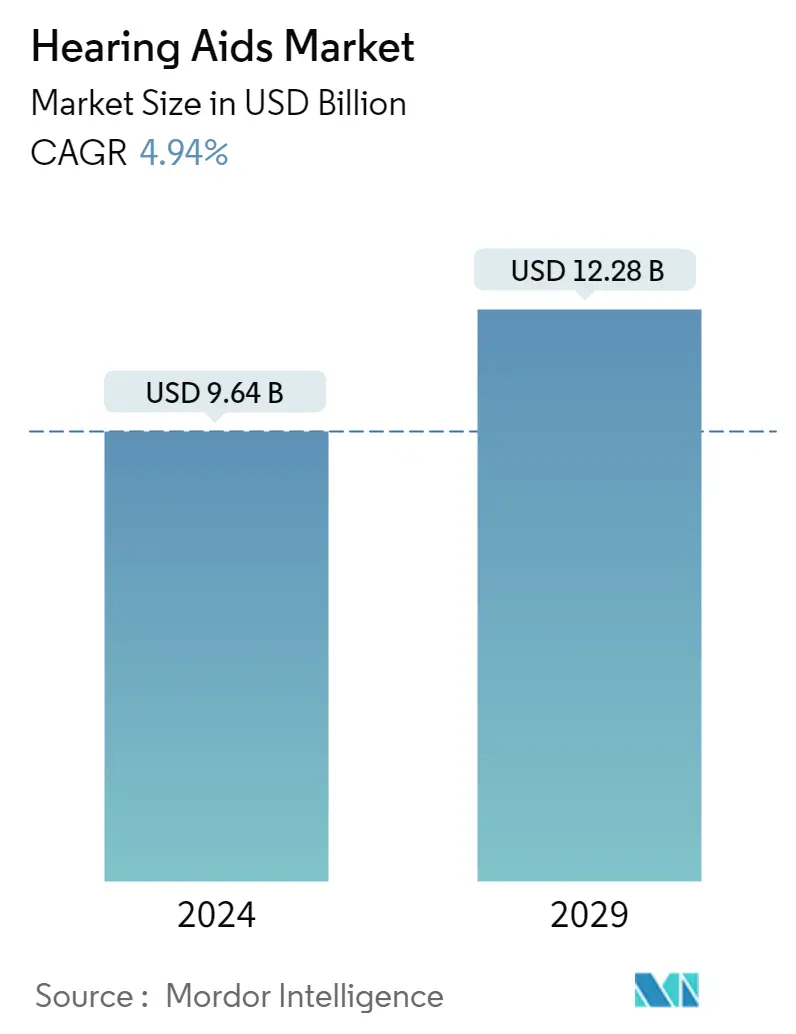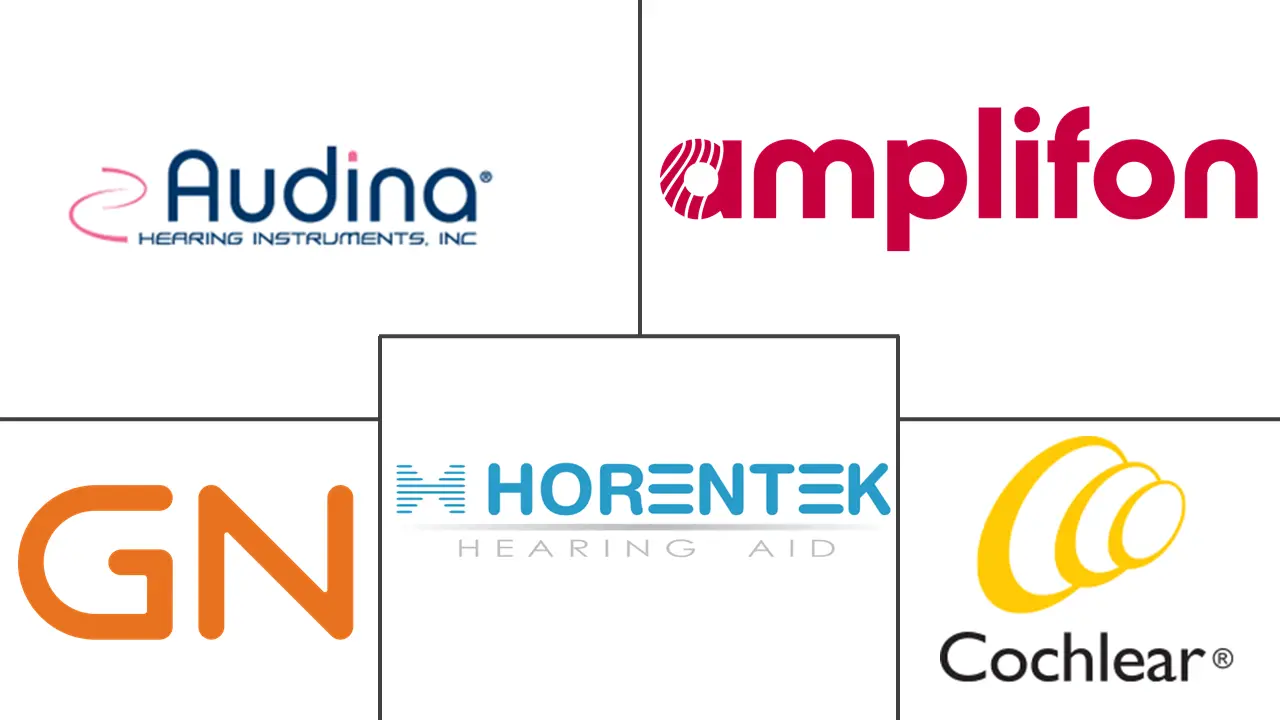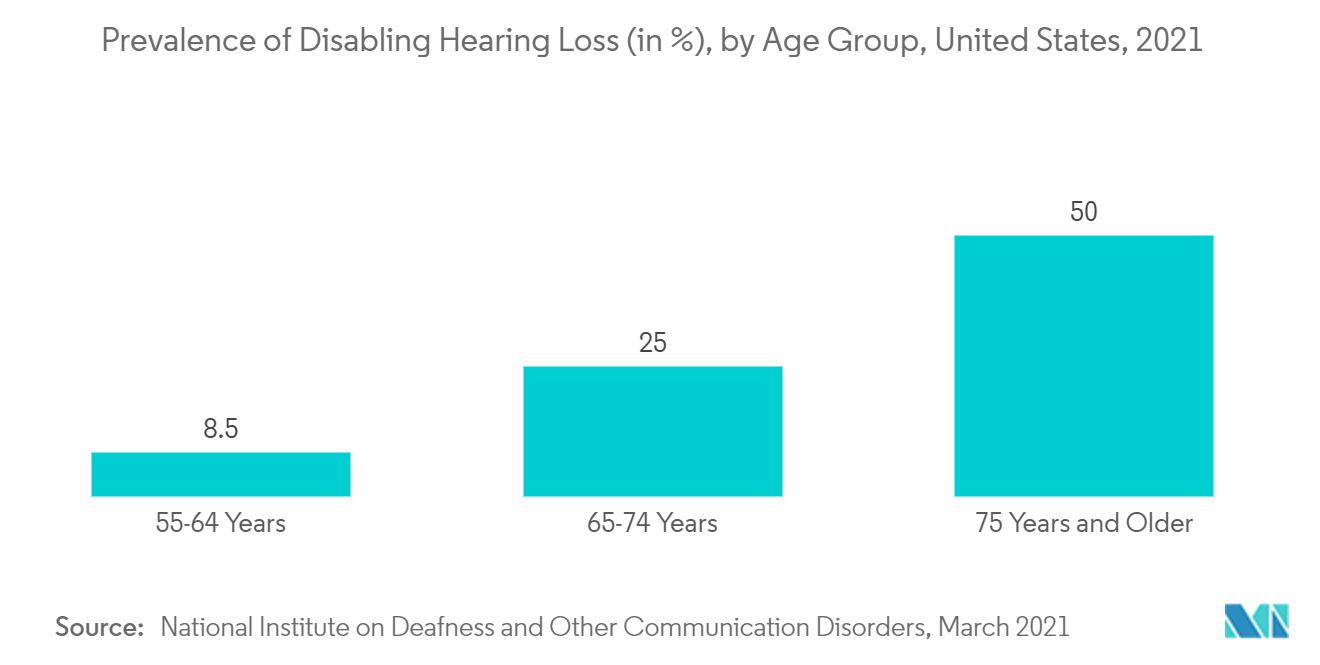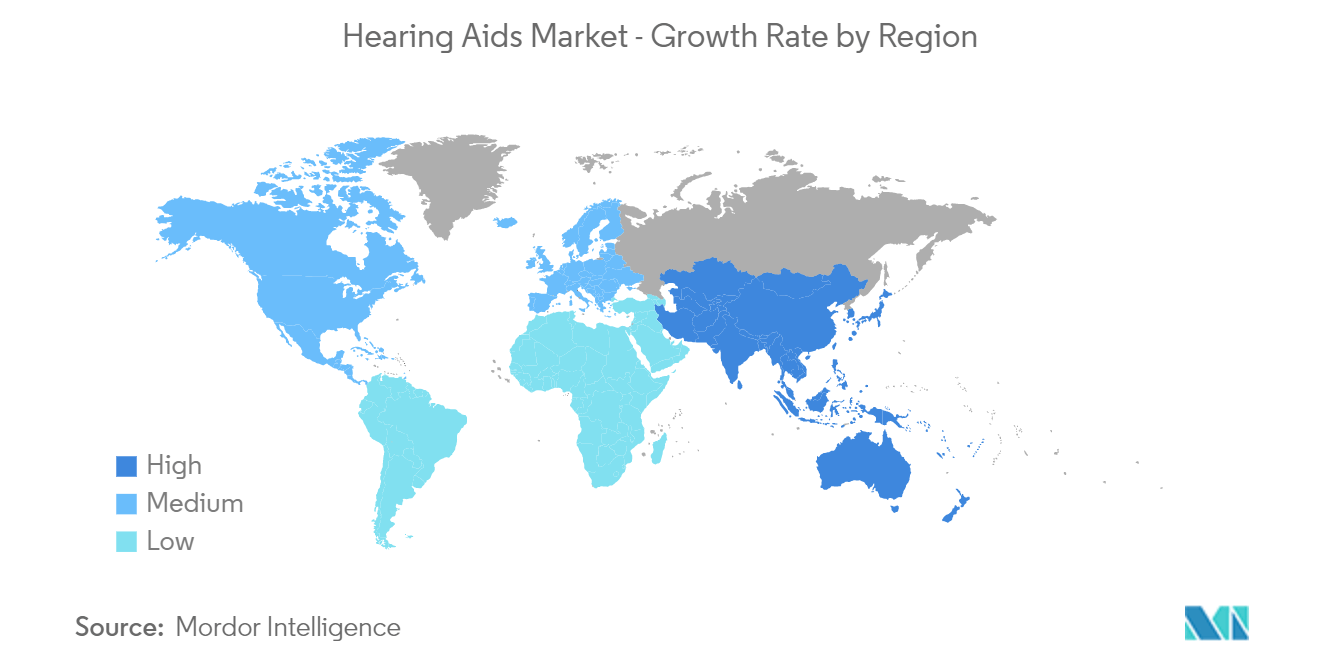Hearing Aids Market Size

| Study Period | 2019 - 2029 |
| Market Size (2024) | USD 9.64 Billion |
| Market Size (2029) | USD 12.28 Billion |
| CAGR (2024 - 2029) | 4.94 % |
| Fastest Growing Market | Asia Pacific |
| Largest Market | North America |
Major Players
*Disclaimer: Major Players sorted in no particular order |
Hearing Aids Market Analysis
The Hearing Aids Market size is estimated at USD 9.64 billion in 2024, and is expected to reach USD 12.28 billion by 2029, growing at a CAGR of 4.94% during the forecast period (2024-2029).
The COVID-19 pandemic was an unprecedented health concern that adversely affected communities, industries, businesses, and lives worldwide. COVID-19 led to disruption in the diagnostics and treatment of people with hearing problems. Due to the COVID-19 breakout, footfall in hospitals and clinics decreased during the early pandemic. For instance, according to the research study published by Europe PMC in September 2021, adult users with cochlear implants and residents of rural areas faced higher challenges during the pandemic as access to healthcare decreased drastically during the COVID-19 pandemic. However, with the decreasing cases of COVID-19, the studied market has started to gain traction and is expected to regain its full potential over the forecast period.
The major propelling factors for the growth of the hearing aid market include the rising burden of hearing loss and raising awareness and initiatives about hearing aid devices among people. For instance, according to the April 2021 report of the WHO, about 2.5 billion people are estimated to have some degree of hearing loss, and approximately 700 million people will need hearing rehabilitation by 2050. According to the same source, about 1 billion young adults risk permanent, avoidable hearing loss due to unsafe listening practices. The WHO data shows the prevalence of hearing impairment and risk worldwide. Thus, the demand for hearing aid devices is expected to increase over the years.
The rising awareness about hearing loss and hearing aid devices among the general population is further expected to act as a catalyst for the growth of the studied market. It will also increase awareness about hearing loss and the benefit of devices to people with hearing impairment. For instance, every year, the 3rd March is celebrated as World Hearing Day by the WHO and respective countries to raise awareness about hearing loss and safe listening. A special grant is provided by WHO to those who wish to do a program on these awareness programs. Hence, with the increased awareness about hearing loss, the awareness about hearing devices is also expected to improve. The studied market is anticipated to grow owing to this factor.
Growing noise pollution throughout the world also has a significant impact on the hearing abilities of people. Noise emission in heavy-duty industries, as well as public carnivals, is expected to damage the hearing capacity of adults, thereby resulting in the increasing demand for hearing aid devices. Moreover, the companies in the market are enhancing their product through technological innovation and launching new devices, which is also expected to augment the growth of the hearing aids market during the forecast period. For instance, in February 2022, Oticon announced introducing the Oticon More technologies into paediatric hearing aids. The new Oticon Play PX family are one of the world's first hearing aids for children with an onboard Deep Neural Network (DNN).
Therefore, owing to the factors above, the studied market is anticipated to witness growth over the analysis period. However, the high cost associated with hearing aids and the availability of alternative products is expected to impede the development of the market over the forecast period.
Hearing Aids Market Trends
This section covers the major market trends shaping the Hearing Aids Market according to our research experts:
Behind the Ear (BTE) Segment is Expected to Hold a Significant Market Share in the Product Type Segment Over the Forecast Period
The behind-the-ear (BTE) hearing aid device segment is expected to hold a significant market share in the studied market in terms of revenue, better connectivity, high efficiency, and easy usage. It is also ideal for most people with hearing problems and any hearing impairment, which increases the patient pool for the device. Behind-the-ear hearing aids are considered the most common type of hearing aid. They have more amplification power as compared to other hearing aids and also have a directional microphone which increases their efficiency. These hearing aids are available in various sizes, from small to large, high-powered, streamlined and barely visible devices. Thus, they are preferred by users and expected to be in high demand over the years.
Other factors propelling the BTE hearing aid segment toward growth are the technological advancements in the devices and the launch of new products by the key market players, which are further expected to complement the development of the studied segment over the years. For instance, in October 2021, Canada-based Unitron launched its latest Stride Blu BTE hearing aids, namely Stride B-PR and Stride B-UP. The Stride Blu BTE hearing aids have a smaller and sleeker design than their predecessor. The Stride B-UP features a multi-function button for easier control and is Unitron's first Ultra Power device to offer direct connectivity. The rechargeable Stride B-PR offers tap control and a full day of listening on a single charge, so wearers can remain engaged in daily activities without pausing to recharge. Thus, these advancements are further expected to increase the adoption of BTE hearing aids by patients.
Therefore, the Behind the Ear (BTE) segment is expected to witness significant growth over the forecast period due to the abovementioned factors.

North America Expected to Hold a Significant Share in the Hearing Aids Market Over the Forecast Period
North America is expected to hold a significant market share over the forecast period, owing to the high prevalence of hearing loss, robust healthcare infrastructure, and greater awareness and adoption of hearing aid devices in the region.
For instance, according to the October 2021 Statistics Canada report, hearing loss and tinnitus were prevalent in Canadian adults, specifically men. Overall, 60% of Canadians of age 19 to 79 years had a hearing health issue like audiometrically measured hearing loss, tinnitus (last year) or both conditions. According to the same source, hearing loss is more common in Canada in older ages. Thus, with the increase in the older population, the burden of hearing loss is further expected to increase, driving the growth in the studied market in the region. So, owing to the area's high prevalence of hearing loss, the region's hearing aid market is expected to grow significantly over the years.
Moreover, in North America, the United States is expected to witness notable growth in the hearing aids market during the forecast period due to the high prevalence and incidence of hearing loss in the country and the increased adoption of hearing aids. For instance, according to the March 2021 National Institute on Deafness and Other Communication Disorders update, about 2 to 3 out of every 1,000 children in the US are born with a detectable level of hearing loss in one or both ears, and approximately 15% of American adults (37.5 million) aged 18 and over report some trouble hearing. As per the same source, based on standard hearing examinations, about one in eight people in the United States (13%, or 30 million) aged 12 years or older had hearing loss in both ears. About 28.8 million adults in the United States can benefit from hearing aids. This data shows a high prevalence of hearing loss in the country. Thus, the demand for hearing aids is likely to increase, driving the growth of the studied market.

Hearing Aids Industry Overview
The hearing aids market is moderately fragmented due to the presence of many market players globally and regionally. The leading manufacturers of the hearing aids market are focused on market consolidation and expansion of their product portfolios. Due to the increased benefits, companies are also focusing on providing advanced hearing aid devices with lithium-ion batteries. Some key players in the hearing aids market include Audina Hearing Instrument Inc., Cochlear Ltd, Amplifon SpA, Horentek Hearing Diagnostics, and GN Store Nord A/S, among others.
Hearing Aids Market Leaders
-
Audina Hearing Instruments, Inc.
-
Amplifon SpA
-
Cochlear Ltd
-
Horentek Hearing Diagnostics
-
GN Store Nord A/S
*Disclaimer: Major Players sorted in no particular order

Hearing Aids Market News
- October 2022- Sony Electronics announced the availability of its first over-the-counter (OTC) hearing aids for the United States market.
- July 2022- LINNER launched NOVA, an antibacterial hearing aid with distinctive features.
Hearing Aids Market Report - Table of Contents
1. INTRODUCTION
1.1 Study Assumptions and Market Definition
1.2 Scope of the Study
2. RESEARCH METHODOLOGY
3. EXECUTIVE SUMMARY
4. MARKET DYNAMICS
4.1 Market Overview
4.2 Market Drivers
4.2.1 Rising Burden of Hearing Loss
4.2.2 Technological Advancements in Hearing Aid Devices
4.2.3 Rising Awareness and Initiatives about Hearing Aid Devices
4.3 Market Restraints
4.3.1 High Cost of Hearing Aid Devices and the Presence of Substitute Products
4.4 Porter's Five Forces Analysis
4.4.1 Bargaining Power of Suppliers
4.4.2 Bargaining Power of Buyers/Consumers
4.4.3 Threat of New Entrants
4.4.4 Threat of Substitute Products
4.4.5 Intensity of Competitive Rivalry
5. MARKET SEGMENTATION (Market Size by Value - USD Million)
5.1 Product Type
5.1.1 Behind the Ear (BTE)
5.1.2 Receiver in the Ear (RITE)/ Receiver in Canal (RIC)
5.1.3 In the Ear (ITE)
5.1.4 Completely-in canal (CIC)
5.1.5 Other Hearing Aid Devices
5.2 Type of Hearing Loss
5.2.1 Sensorineural Hearing Loss
5.2.2 Conductive Hearing Loss
5.3 Technology
5.3.1 Conventional Hearing Aids
5.3.2 Digital Hearing Aids
5.4 Patient Type
5.4.1 Adults
5.4.2 Pediatrics/Children
5.5 Geography
5.5.1 North America
5.5.1.1 United States
5.5.1.2 Canada
5.5.1.3 Mexico
5.5.2 Europe
5.5.2.1 Germany
5.5.2.2 United Kingdom
5.5.2.3 France
5.5.2.4 Italy
5.5.2.5 Spain
5.5.2.6 Rest of Europe
5.5.3 Asia-Pacific
5.5.3.1 China
5.5.3.2 Japan
5.5.3.3 India
5.5.3.4 Australia
5.5.3.5 South Korea
5.5.3.6 Rest of Asia-Pacific
5.5.4 Middle East and Africa
5.5.4.1 GCC
5.5.4.2 South Africa
5.5.4.3 Rest of Middle East and Africa
5.5.5 South America
5.5.5.1 Brazil
5.5.5.2 Argentina
5.5.5.3 Rest of South America
6. COMPETITIVE LANDSCAPE
6.1 Company Profiles
6.1.1 Amplifon SpA
6.1.2 Audina Hearing Instruments Inc.
6.1.3 Demant AS
6.1.4 Cochlear Ltd
6.1.5 Eargo Inc.
6.1.6 GN Store Nord A/S
6.1.7 Horentek Hearing Diagnostics
6.1.8 MED-EL
6.1.9 Medtronic PLC
6.1.10 WS Audiology AS (Sivantos Group, WIDEX)
6.1.11 Sonova Holding AG
6.1.12 Starkey Hearing Technologies
- *List Not Exhaustive
7. MARKET OPPORTUNITIES AND FUTURE TRENDS
Hearing Aids Industry Segmentation
As per the scope of the report, hearing aids are sound-amplifying devices that treat hearing impairment. These devices differ by design, the technology used to achieve amplification, and special specific features. The Hearing Aids Market is segmented by product type (Behind the Ear (BTE), Receiver in the Ear (RITE)/Receiver in Canal (RIC), In the Ear (ITE), Completely-in canal (CIC), and other hearing aid devices), type of hearing loss (sensorineural hearing loss and conductive hearing loss), technology (conventional hearing aids and digital hearing aids), patient type (adults and paediatrics/children), and Geography (North America, Europe, Asia-Pacific, Middle East and Africa, and South America). The market report also covers the estimated market sizes and trends for 17 countries across major regions globally. The report offers the value in (USD million) for the above segments.
| Product Type | |
| Behind the Ear (BTE) | |
| Receiver in the Ear (RITE)/ Receiver in Canal (RIC) | |
| In the Ear (ITE) | |
| Completely-in canal (CIC) | |
| Other Hearing Aid Devices |
| Type of Hearing Loss | |
| Sensorineural Hearing Loss | |
| Conductive Hearing Loss |
| Technology | |
| Conventional Hearing Aids | |
| Digital Hearing Aids |
| Patient Type | |
| Adults | |
| Pediatrics/Children |
| Geography | ||||||||
| ||||||||
| ||||||||
| ||||||||
| ||||||||
|
Hearing Aids Market Research FAQs
How big is the Hearing Aids Market?
The Hearing Aids Market size is expected to reach USD 9.64 billion in 2024 and grow at a CAGR of 4.94% to reach USD 12.28 billion by 2029.
What is the current Hearing Aids Market size?
In 2024, the Hearing Aids Market size is expected to reach USD 9.64 billion.
Who are the key players in Hearing Aids Market?
Audina Hearing Instruments, Inc., Amplifon SpA, Cochlear Ltd, Horentek Hearing Diagnostics and GN Store Nord A/S are the major companies operating in the Hearing Aids Market.
Which is the fastest growing region in Hearing Aids Market?
Asia Pacific is estimated to grow at the highest CAGR over the forecast period (2024-2029).
Which region has the biggest share in Hearing Aids Market?
In 2024, the North America accounts for the largest market share in Hearing Aids Market.
What years does this Hearing Aids Market cover, and what was the market size in 2023?
In 2023, the Hearing Aids Market size was estimated at USD 9.19 billion. The report covers the Hearing Aids Market historical market size for years: 2019, 2020, 2021, 2022 and 2023. The report also forecasts the Hearing Aids Market size for years: 2024, 2025, 2026, 2027, 2028 and 2029.
What are the latest advancements in Hearing Aid technology?
The latest advancements in Hearing Aid technology are a) Bluetooth connectivity b) Noise cancellation c) Artificial intelligence-powered sound processing
Hearing Aid Industry Report
The global hearing aids industry is witnessing remarkable growth, driven by the rising prevalence of hearing loss, cutting-edge technological advancements, and an increasing awareness of auditory health. Innovations such as invisible, AI, and Bluetooth-enabled hearing aids are enhancing user experiences, while the growing elderly population underscores the need for such devices. Government and regulatory initiatives for early detection and awareness campaigns further fuel the market's expansion. Distribution through retail stores and e-Pharmacy sales channels broadens access to these advancements, offering personalized experiences and facilitating informed purchasing decisions. The hearing aids industry benefits from regional dynamics, with Europe leading due to heightened awareness and an aging demographic, and the Asia Pacific region poised for rapid growth through technological and strategic initiatives. Products like behind-the-ear (BTE) and canal hearing aids are preferred for their adaptability and discreetness, respectively, with digital hearing aids leading the technology front by providing superior sound quality and customization. Overall, ongoing technological innovations and a focus on improving life quality for those with hearing loss are set to drive the hearing aids industry forward. Get a sample of this industry analysis as a free report PDF download.



